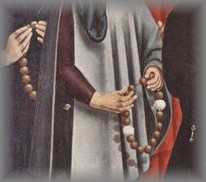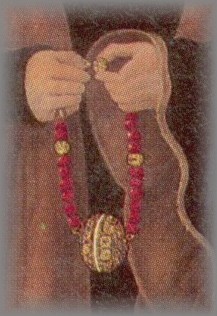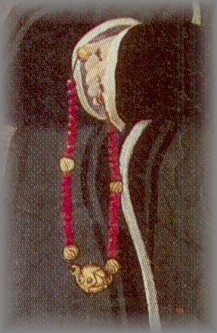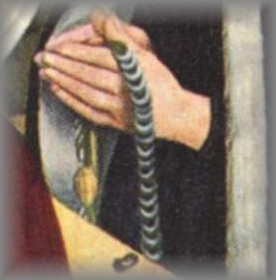| MUSEUM
Antique Rosaries |
HISTORY
of the Rosary |
for you index |
cord instructions |
LINKS |
EMAIL
US+
877 695 3561 |
 |
 |
 |
 |
|
OF PAINTINGS SHOWING ROSARIES The rosary has been worn throughout history not only by religious but devoted laity. There are periods of history, especially the 15th and 16th century when the rosary became stylish to wear. Coral was very popular. And for many, the more elegant the rosary the more impressive it became. This caused great concern amongst religious who would ban wearing of rosaries from time to time. + The purpose of this little museum is to show how the rosary was imaged by early painters as it was a tradition to include symbols or attributes with the figure to show interests or their love for God. The rosary was worn by many saints and martyrs so to picture it was important. For more resource information please contact the museums listed below. (Pictures link directly to Museum) for more infromation
see
|
|
*MARY, QUEEN of SCOTS* |
|
*DISKS and LARGE BEADS* |
|
Showing several prayer bead styles used during the 15.c
COUNTING DISKS Flat disks attached to a leather thong or tied into a fiber cord are turned over one at a time as prayers are counted. +
ABOVE: Flat bone discs were used until recently for counting prayers. Pater beads appear to be amber. Rosaries of coral were believed to not only have healing properties but to give wisdom. (Middle Ages). +
GAUDS OR PATERS The Pater beads of the period became very 'Gaudy' or ornate so were called 'Gauds' |
|
*CORAL POMANDER BEADS* |
|
(French pomme dambre, i.e. apple of amber) + A pomander, in its original concept, is a ball made of perfumes, such as ambergris, musk, cloves or myrrh or civet . it was worn or carried in a box or case often shaped like flowers and other natural shapes or a bead, as a protection against infection during times of pestilence and plague. Coral was considered to carry special healing powers so was very popular to use along with the pomancer beads. +
ABOVE: Grien was from Schwabish Gmund, a small are in Germany known for its silver craft work and filigree Rosary Making BELOW: Portrait of the Artists Father by Albrecht Durer (The Uffizi Gallery - Florence) +
2nd BELOW: Little baby Jesus resting on his mother's lap wearing coral rosary around his neck. +
FILIGREE BEADS (The pomander beads were usually filigree or openwork so the aromas could escape) It was also used to modify bad smells as baths were not a daily event. (See examples pomander and coral below on rosaries) |
|
*COUPLES in ART* |
|
POMANDER and CORAL Claus Stalburg des Reichen (1469-1524)
POMANDERS ON ROSARIES Pomanders were hung from a neck chain or attached to the waist or on a rosary. Royalty and wealthy preferred Pomanders of precious medals (gold or silver) and often set with precious stones while the common folk wore simple cloth bags around their necks. It was not unusual for a Pomander to have several partitions to divide different aromatic herbs, spices, crushed flowers or perfumes. The British Museum has an an early 16th Spanish pomander set with emeralds, that was found in the Thames. If only it could talk! + Claus Stalburg des Reiche's wife Margarethe of the Rhine.
SWEET INCENSE OF PRAYER Others believe the aroma is like the ‘sweet incense of prayer rising to heaven’ and is given to God. The circle of beads will eventually be seen as similar to a wedding ring or God never ending. Women also enjoy adding small trinkets such as figurines, images and gemstones to their rosaries along with the scented dried fruit and flowers. + CORAL Coral was believed to carry special healing powers and give the pray-er or wearer spiritual insight, an open heart and protection against evil. Very popular usage in rosaries for children as well as adults. Coral was also believed to enhance ones memory. |
|
*PRAYER BEADS in ART* |
|
BELOW: Large coral Ave beads are punctuated with metal Paters suggesting the configuration may be smilar to todays's rosary. +
FOLLOW THE LINKS BELOW FOR MORE PORTRAITS More portraits below showing attributes of the subject of importance in the painting. |
+ 'All night she spent in bidding of her bedes And all the day in doing good and Godly deeds' Vision of Piers the Plowman by William Langland - 1370 |
|
Rogier van der Weyden, National Gallery, London + A magnificent example of a single strand of prayer beads (amber) with a tassel at each end. Note too, the beads were drawn across the cord as they were said. +
|
|
THhE MERODE ALTARPIECE (L' Annonciation - 1425,26 - left and middle panel only) Workshop of Robert Campin (South Netherlandish, active by 1406, died 1444) The Cloisters, Metropolitan Museum of Art, New York Annunciation Triptych (Merode Altarpiece), ca. 1427–1432 + BELOW LEFT: A man and woman kneel before an open door, facing the center panel (Annunciation) She holds a coral rosary with white beads at either end. Oil paint on oak +
|
|
ARRIGI ARNOLFINI AND GIOVANNA CENAMI - 1434 Jan van Eyck The National Gallery, London + 30 crystal clear beads reflect their light on the wall behind making it hard to tell if there are one or two rosaries! An elegant Passementerie tassel, brobably of gold threads and boullion hang from each end. This work is filled with symbolism including 10 miniature paintings of the passion of Christ aroun mirrors edge. +
|
|
*GERMAN MADONNA* |
|
|
MISSION STATEMENT Our vision is to provide the finest handmade rosaries, chaplets and other fine religious art forms for personal worship we can make using the finest supplies available. The Guild believes the work of our hands should give visual Glory to God, therefore for us, the best for you is very, very important. +++ QUESTIONS? ask us: copy and paste beadsong@hotmail.com OR CALL WEEKDAYS - 9 to 5central 877.695.3561
MUSEUM
- HISTORY
- PRAYER
OFFICE
HOURS
|
|
secure-online - credit card -[or]- mail in - mo/personal check |